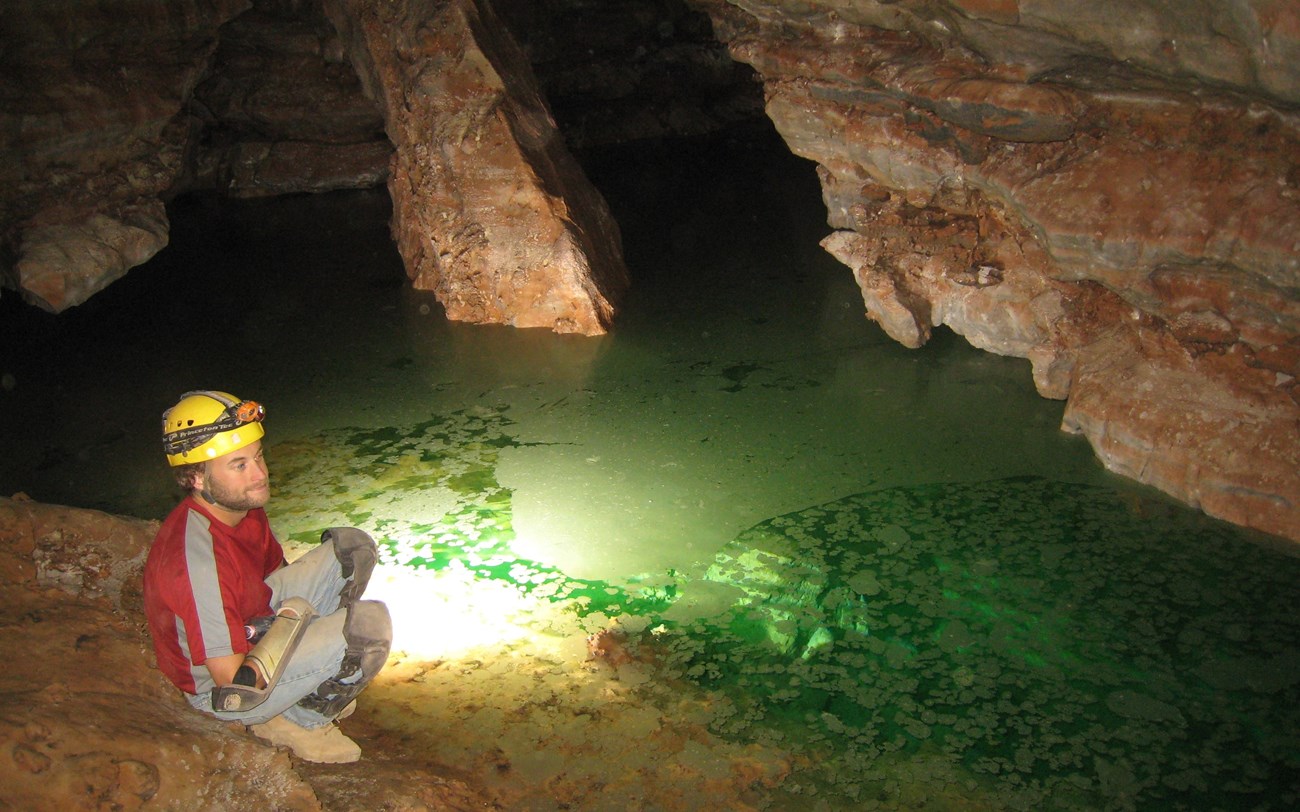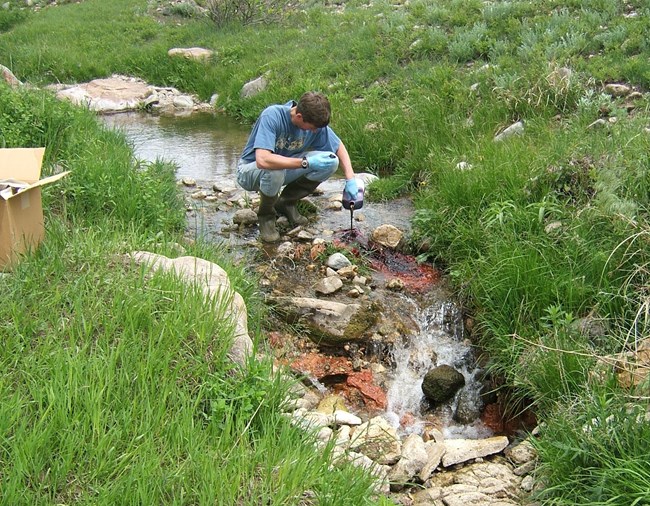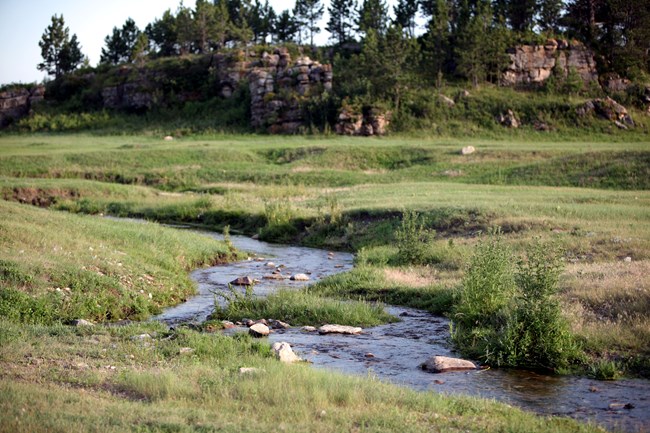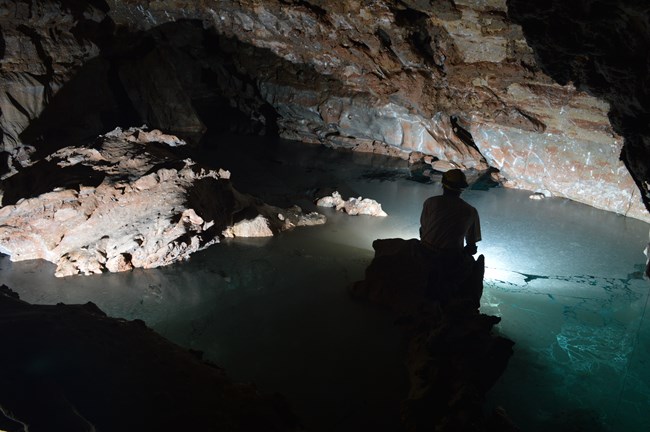Last updated: July 30, 2024
Article
Following Water Movement Using Dye Tracing

NPS Photo / Sprouse
Wind Cave National Park sits above the Madison Aquifer, a large underground water source that provides water for the park and parts of South Dakota and Wyoming. The intersection of Wind Cave and the Madison Aquifer creates large lakes within the cave. Due to western South Dakota’s relatively dry climate, the park does not have many major surface water sources. These limited sources may be seen as insignificant because of their size, but studies reveal how they are influenced by activities outside the park and, in turn, how they influence Wind Cave and the Madison Aquifer.

NPS Photo / Rod Horrocks
How is water in the park managed and protected?
Water studies within the park reveal where it is going, what it is connected to, and how it may be impacted by human and non-human activities. Some studies collect samples and analyze them in the lab. An analysis done in 2002 and 2003 by the USGS showed chemicals from consumer goods and septic systems present in the park’s three streams – Beaver, Cold Spring, and Highland Creek. This meant outside forces were polluting water flowing into the park (Ohms, Water Resources of Wind Cave National Park, 2012).
Another technique used to study water is dye tracing. Dye trace studies inject dye into the ground and track its movements using dye receptors, small mesh bags that contain charcoal. Researchers can look at a water source to see if the dye has changed the color of the water, but dye receptors analyzed in a lab can confirm very small amounts of dye in a water source. Dye tracing also helps scientists visualize how water moves from one place to another. Several dye trace studies done in the park are summarized below.

NPS Photo
Why do we care about dye trace studies?
Understanding how water systems are connected is important. Depending on how they are joined, pollutants can travel from one water source to another. If polluted water enters the cave, the rare and fragile ecosystem could be damaged. Polluted surface water that reaches the aquifer may make drinking water unsafe. Knowing where pollutants come from and where they go can help prevent future problems, and dye tracing is a great tool to use to study these movements.
Individual Studies
Fluorescein was present in a few spots, but later research showed that these were probably false positives. Rhodamine appeared in a few spots in the cave a couple days after injection, and it appeared in the park’s well. However, rhodamine used in another dye trace at Beaver Creek was deemed the likely reason for the presence of the dye in the well. Clear results did not come from Davis’s research, but her work set the foundation for future dye trace studies. (Nepstad, 2015).
In mid-June of 1993, researchers injected a rhodamine WT solution into the ground over the cave’s Club Room. A month later, they injected a fluorescein solution in the ground over the southeast section of the cave. After two years, no samples from the cave showed the presence of dye from either injection.
Even with no dye present, researchers learned a few things. When they compared their own results with Davis’ 1986 study, Davis’ injections were right next to park facilities, and rhodamine used in her study appeared within a couple of days after injection. The 1993 injections occurred farther away from park facilities and in places where the ground between the surface and the top of the cave was very thick. This indicated either the water flowed parallel to the surface across the landscape, or that the flow underground was so slow or complex that it wouldn’t reach the cave for a few years. This also means that park facilities sat on a thin portion of ground over the cave. This caused concern and led to more dye traces to add to the research Davis had done.
Supplemental studies began in 1996 with dye injected at and around Davis’ research sites. A rhodamine WT and water mixture injected at the south parking lot drain produced immediate results at a site in the cave below the drain. Dye levels increased within hours, then
began falling almost two weeks later. When other rain events occurred the level of the dye increased again, then fell as the amount of water entering the site decreased. With the known link between the drain and the cave, concern grew about how much runoff from the parking lot was entering the cave and the potential harm it caused.
Fluorescein dye was injected at the picnic area site Davis used in her research and a few other sites around the cave’s northern region. Samples collected over the next year yielded no fluorescein in that portion of the cave. The spot at the picnic area told a different story. Fluorescein appeared at the same spot in the cave where Davis had a false positive result, about 449 meters from the injection site. Researchers learned that water was indeed moving across the landscape then down into the cave (Nepstad, 2015).
A study in 2008 monitored the relationship between a few water sources within the cave: Rebel River, What the Hell Lake, and Calcite Lake. Fluorescein was injected in What the Hell Lake, with monitoring for the presence of dye at Rebel River and Calcite Lake. A month after injection, dye was visible within all three bodies of water. Lab analysis of dye receptors at Rebel River and Calcite Lake confirmed the presence of fluorescein. This meant water from What the Hell Lake flowed into Rebel River and Calcite Lake. Samples taken from the park wells showed no presence of dye (Ohms, Wind Cave Dye Trace, 2011).

NPS Photo / Dan Austin
Summary
These studies show that water above the ground, in the ground, and in the cave are connected. They provide insight on how park infrastructure and other activities in and out of the park impact water sources and can help inform decisions on future developments inside and outside of the park.
Sources
Ohms, Marc, Wind Cave Dye Trace, 2011.
Ohms, Marc. Highland Creek Dye Trace, 2012.
Ohms, Marc. Water Resources of Wind Cave National Park, 2012.
Nepstad, James. Dye Tracing Through the Vadose Zone Above Wind Cave, Custer County, South Dakota, 2015.
